Innovation is more important than ever, but truly creative ideas can be hard to generate. You convene your brightest minds around a table to solve an issue, hoping for fresh ideas to flow forth, but instead face another boring spiral of groupthink, stale ideas, and safe thinking.
Over the past year at Free Range, we’ve facilitated countless workshops to help teams unlock innovative thinking based on the mindsets found in our co-founder Jonah Sachs’ new book Unsafe Thinking. Along the way, we’ve learned a few things that might make your next brainstorm more fruitful:
1. Set your intention
Before you begin, encourage your team to take 3 quiet minutes to think deeply about why the problem at hand is worth solving. Ask them to get into an empathetic state of mind by considering who the solution will benefit. It might take a few rounds of asking “but why?” to get to the level where you can connect the issue to real people, but every problem matters to someone, even if only tangentially.
This pause is critical for your team members to see the brainstorm as an opportunity to make an impact instead of a chance to throw a few sticky notes on a wall and call it a day. It also encourages participants to get out of their own heads and start thinking from the perspective of the end user.
2. Appoint an instigator
Groupthink is real, and often niceness wins out over creatively challenging each other, so publicly choose one person to be an instigator. Empower this person to call out ideas as too safe, refuse to accept “me too” answers, and push every member to go deeper in their thinking.
By making it socially acceptable for this person to challenge others, you can push past the tendency of groups to stick to safe, practical ideas that won’t rock the boat.
3. Combat shared information bias
Before diving into group discussion, encourage your team members to write down all relevant information, real-world examples, personal experience, and related research that comes to mind. Then have each member share their entire list, even if it overlaps with what others have offered up.
We often assume that our knowledge is common knowledge. Other members of the group surely have read the same books, heard of the same studies, watched the same documentaries, and consumed the same news as we have, so why risk being seen as stating the obvious? But this assumption can lead to sitting on information that could stimulate creative thinking in others.
4. Reframe the problem
Sometimes you need to think about the problem differently to arrive at novel solutions. Try framing the problem as all about emotion and have the group come up with two solutions using that angle. Then make it about technology, and find two more solutions. Make it physical, make it about people and relationships, make it about process. Applying these lenses might feel silly with some issues, but they will spark new ways of looking at the problem at hand.




